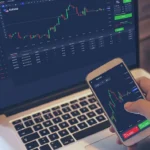Margin trading involves borrowing funds to increase the size of your trading position. In the context of Bitcoin, this means a trader opens larger positions than their account balance would typically allow. For example, with 10 x leverage, a trader with $1,000 in their account could potentially open a position worth $10,000. This amplification of trading power profits if the market moves in the trader’s favour. However, it’s crucial to understand that losses are equally magnified, making margin trading a double-edged sword in the volatile Bitcoin market.
Margin trading might be advisable
While margin trading carries inherent risks, there are scenarios where it might be a suitable strategy for experienced Bitcoin traders:
- During periods of low volatility
Bitcoin markets occasionally experience periods of relative calm, with prices moving within a narrow range. During these times, margin trading can be used to capitalize on small price movements that would otherwise yield minimal profits. By leveraging their position, traders turn these minor fluctuations into more substantial gains. However, it’s crucial to remember that even in less volatile periods, unexpected news or market events quickly lead to sharp price movements. Traders must remain vigilant and be prepared to adjust their positions rapidly.
- Strong technical indicators align
Experienced traders who rely on technical analysis might find margin trading particularly useful when multiple strong indicators align, suggesting a high-probability trade. For instance, if key moving averages, trend lines, and momentum indicators all point towards a bullish or bearish move, a trader might use a margin to maximize their potential profit from this setup. It’s important to note that no indicator is infallible, and even in the strongest technical setups, management remains paramount, especially when using leverage.
- 3. To capitalize on major news events
The cryptocurrency market is highly sensitive to news, and coin target ai is no exception. When major positive news breaks such as a country adopting Bitcoin as legal tender or a large corporation adds it to its balance sheet prices surge rapidly. In these scenarios, margin trading traders maximize their exposure to the potential upside. Conversely, negative news leads to sharp declines, offering opportunities for short-selling with leverage. However, trading on the news requires quick reflexes and understanding of the types of information that impact the market.
Before engaging in margin trading
While the scenarios above highlight potential use cases for margin trading in the Bitcoin market, it’s essential to approach this strategy with caution.
- Understand the costs
Margin trading involves borrowing funds, which come with interest charges. These costs eat into profits, especially for longer-term positions. Traders need to factor in these expenses returns.
- Market volatility can lead to liquidation
Bitcoin’s price is highly volatile, with sudden price swings not uncommon. In margin trading, if the market moves against your position and your losses approach the amount of collateral in your account, you risk having your position liquidated. This means the exchange will automatically close your position to prevent further losses, potentially resulting in the loss of your entire margin.
- Emotional control is crucial
The high-stakes nature of margin trading leads to emotional decision-making, which is often detrimental in trading. It’s essential to have a clear strategy discipline, even in the face of gains or losses.
The Bitcoin market is constantly evolving, influenced by technological developments, regulatory changes economic factors. Successful margin traders commit to ongoing education and stay abreast of market trends and news that could impact Bitcoin’s price.


 Understanding the Document Requirements When Filing Taxes
Understanding the Document Requirements When Filing Taxes  What are the best gift cards for subscription services?
What are the best gift cards for subscription services?  Different ways to pay for your plastic surgery procedure
Different ways to pay for your plastic surgery procedure  Benefits of Investing in Mid-Cap Funds
Benefits of Investing in Mid-Cap Funds  Why Funding Partnerships Demand Personal Guarantors and How A Funding Partnership Agency Can Help
Why Funding Partnerships Demand Personal Guarantors and How A Funding Partnership Agency Can Help  How to Avoid Common Financial Mistakes That Hurt Your Wealth
How to Avoid Common Financial Mistakes That Hurt Your Wealth  Bank Nifty Index and Best Demat Account Apps for Trading
Bank Nifty Index and Best Demat Account Apps for Trading  Essential Trading Tools Every Forex Trader Should Use in 2025
Essential Trading Tools Every Forex Trader Should Use in 2025  Why Estate Planning Service is Essential in Wealth Management
Why Estate Planning Service is Essential in Wealth Management 